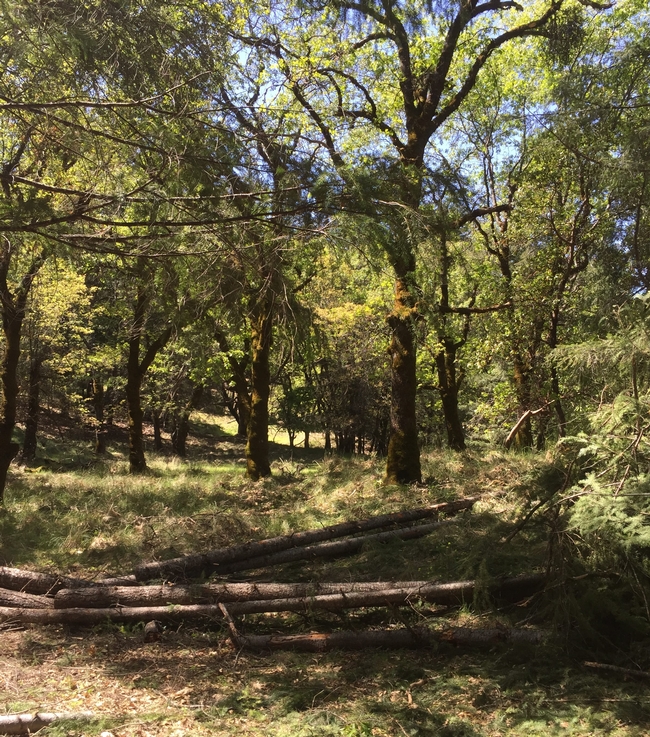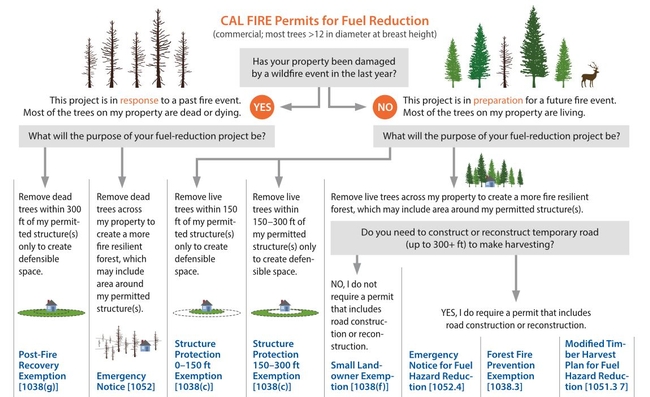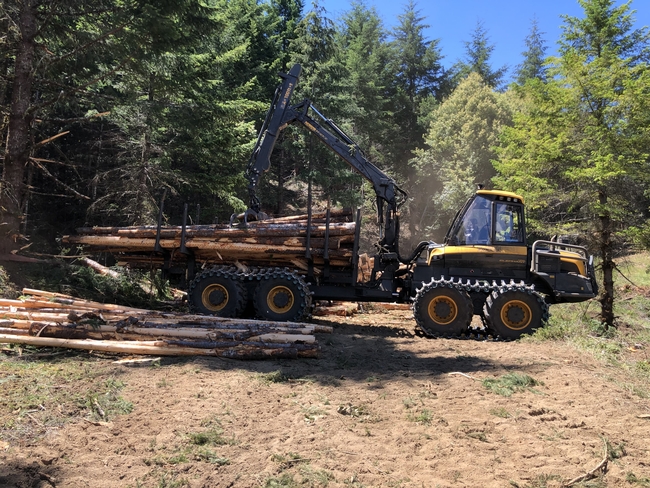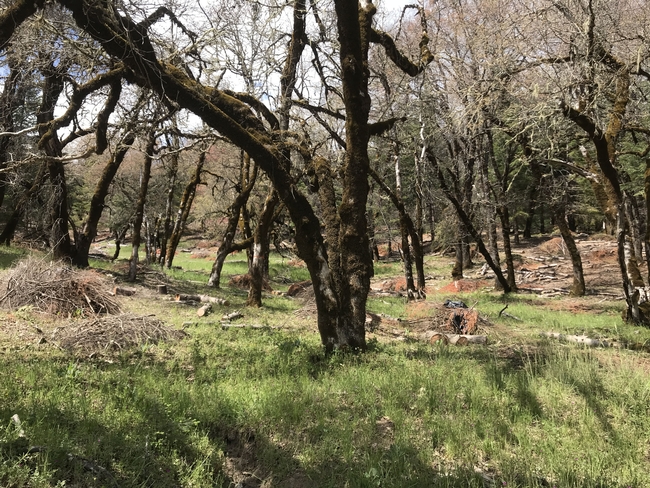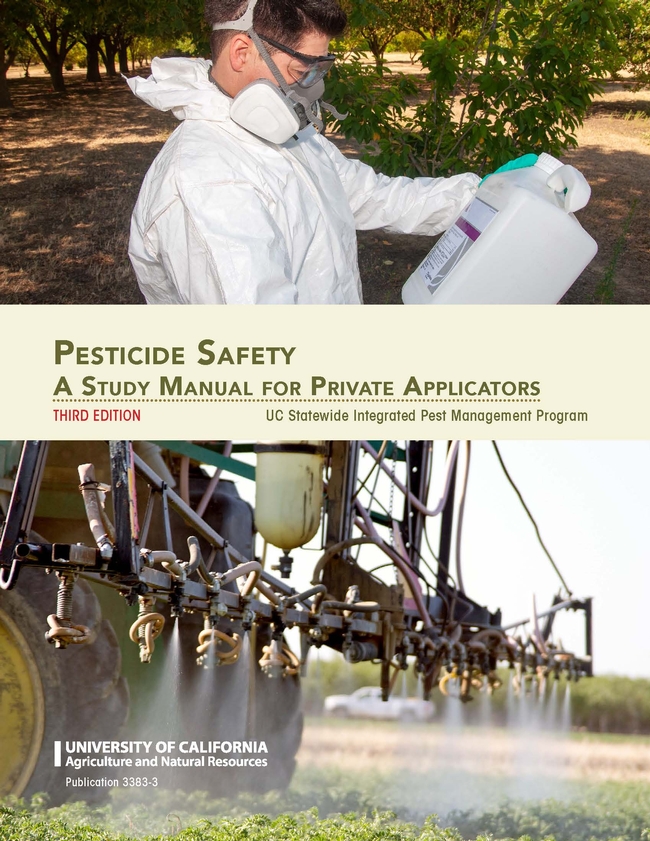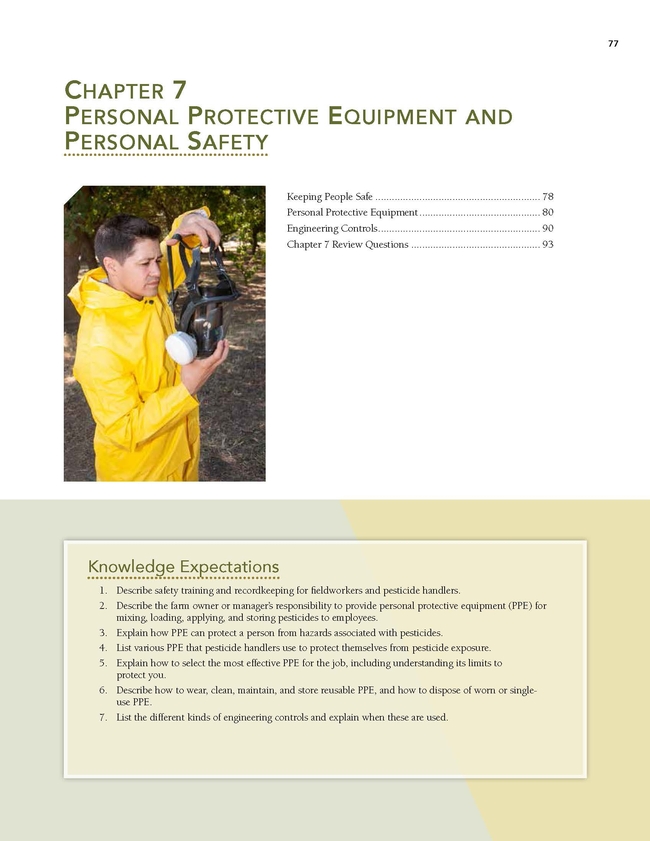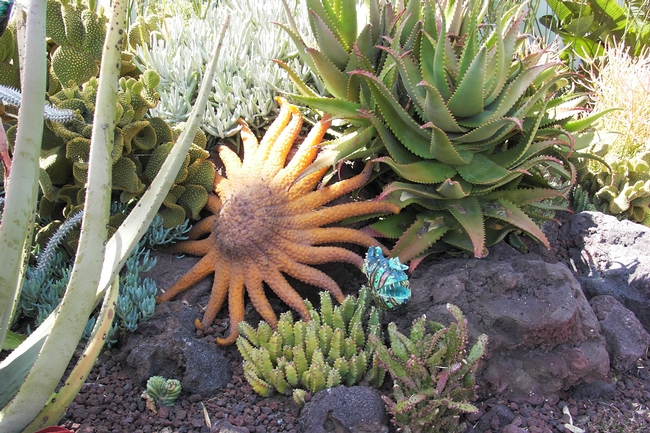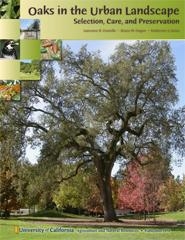Posts Tagged: publications
Free wildfire publication simplifies understanding fuel-reduction permits on private land
UCCE forest advisor helps landowners, community groups determine best project options
As Californians prepare for another year of drought and an anticipated intense fire season, landowners and organizations across California have been working to reduce forest fuels – flammable woody material – that can endanger their properties and communities.
For many of them, however, their urgent efforts hit a sizable speed bump: a massive rulebook that describes, amid a thicket of other information, the permits required before people can treat or remove fuels – as well as a litany of attached requirements, restrictions and stipulations.
“The California Forest Practice Rules are 410 pages, in font size 6,” said Yana Valachovic, UC Cooperative Extension forest advisor for Humboldt and Del Norte counties and registered professional forester. “Trying to figure out what permit vehicles make sense in the rulebook is not easy even for the experienced professional forester.”
To assist private landowners and community groups in deciphering the rules and determining their most cost-effective options, Valachovic took the lead in writing a new guide, “Planning and Permitting Forest Fuel-Reduction Projects on Private Lands in California,” available as a free resource in the UC Agriculture and Natural Resources catalog.
“We tried to create a system where all the permits are laid out side-by-side, and put in a decision tree framework to help make it easier,” said Valachovic, highlighting the publication's tables that break down the project goals and parameters a permit applicant should think about when weighing their choices.
Considerations include whether the project is pre- or post-wildfire, the location and dimensions of trees targeted for removal, the conditions of the site before and after the project, potential time limits, commercial options, and, crucially, budget constraints – given that the permitting process could comprise up to one-third of total project costs.
A primer for planning and preparation
Chris Curtis, the unit forester for CAL FIRE's Humboldt-Del Norte Unit, said that he and his colleagues are grateful for this new tool and plan to use it as an “over the counter” handout for community members. He added that the charts summarizing timber-harvesting regulations and possible funding sources are especially helpful.
“These give a landowner a starting place to sort through the many commercial timber harvesting documents and fuel-modification project funding source options available,” Curtis said. “A landowner is self-guided to a few options that will seem most appropriate, and this will facilitate a resource professional to assist that person in selecting the most appropriate permitting.”
The publication helps prepare the landowner or community entity (such as Resource Conservation Districts, Fire Safe Councils or other concerned groups) for the types of questions that might come up in preliminary planning conversations with a registered professional forester or RPF.
Just as a homeowner would talk with a contractor before tackling a construction project, landowners and community groups must consult with an RPF, Valachovic said. RPFs have the specialized knowledge of forest practice rules and regulations related to water, air quality and endangered species protections, and the license to file the permitting documents.
“That's what I do in my job: Landowners come to me and we start talking about goals and objectives,” she said. “We start thinking about potential timelines – which goals are short-term, which are long-term – and how we can put an operational plan together to help those landowners achieve their goals.”
Long-term projects, short-term actions
Among the many practical tips outlined in this guide, Valachovic emphasized one in particular: for landowners dipping their toes into fuel reduction for the first time, keep the project “simple and realistic.”
In the short-term, however, Valachovic stressed that the extremely dry conditions across the state make it imperative for Californians to harden their homes, manage the fuels (i.e., landscape plants, stored wood, tall grass, etc.) immediately adjacent to their homes, and devise and review family emergency plans; see UC ANR's Wildfire Preparation page for detailed information and resources.
“There are a lot of immediate actions that people can be doing this year to help mitigate their wildfire risks and prepare for the unexpected,” she said.
In addition to Valachovic, co-authors of “Planning and Permitting Forest Fuel-Reduction Projects on Private Lands in California” are Jared Gerstein of BBW Associates and Brita Goldstein, UCCE staff research associate in Humboldt and Del Norte counties; both are registered professional foresters.
More detail, key updates in new edition of pesticide safety manual
Publication in English, Spanish prepares private applicators for state exam
Expanded from four chapters in the previous edition to 12, the third edition of Pesticide Safety: A Study Manual for Private Applicators aims to be more than just a study guide.
The manual, available for purchase in English and Spanish, provides much more detail on essential processes and procedures that will help keep applicators safe while using pesticides – as well as reduce environmental impacts from misapplication.
Published by University of California Agriculture and Natural Resources in collaboration with the state's Department of Pesticide Regulation, the manual – intended for members of the agricultural community who own, manage or work on farms that use restricted-use pesticides – also includes substantial updates.
“The information in the book they were using was way out of date,” said writer/editor Shannah Whithaus, senior editor for pesticide safety education with UC ANR's Statewide Integrated Pest Management Program. “Also, the book was much, much shorter than it needed to be, because it wasn't providing enough information for people to safely apply pesticides, given the complexity of the regulatory environment we're in now.”
The new manual reflects important changes to federal and state regulations since the publication of the previous edition in 2006.
“There are significant regulatory updates which help you stay up-to-date with safety rules and standards – and protect your workers from overexposure to pesticides,” said Lisa Blecker, technical editor of the publication, and currently a pesticide safety educator at Colorado State University.
In addition to emphasizing the broader ecological ramifications of improper pesticide use, the manual includes information on subjects that might get short shrift in other manuals, such as the correct calibration of equipment to ensure accuracy of application.
“All of that is now in the book and fully fleshed out,” Whithaus said. “[Applicators] are going to be able to do that much more effectively using the new book, compared to the old one – it was really hard to be thorough in 80-some pages.”
The new edition – totaling more than 200 substantive pages – also features a more streamlined and user-friendly layout modeled after a sister publication, The Safe and Effective Use of Pesticides, written for commercial applicators.
“A significant update is a layout that is not only beautiful, but helps you identify key information you need to know in order to make safe and effective pesticide applications,” Blecker explained.
She highlighted the “knowledge expectations” listed at the beginning of each chapter and in the margins of the book, next to the relevant passages. The statements serve as “visual cues” to help readers learn and retain the material they need to pass California DPR's certification exam for private applicators.
And while the manual functions as an improved study aid for owners, managers and workers who apply pesticides, it doubles as a reference that they can turn to for years to come.
“It's going to be able to serve as a reference manual, as opposed to just a study guide,” Whithaus said. “You really will be able to use this book as a tool to help you do better in managing your land.”
The manual, listed at $29, is available for purchase in English at https://anrcatalog.ucanr.edu/Details.aspx?itemNo=3383 and in Spanish at https://anrcatalog.ucanr.edu/Details.aspx?itemNo=3394.
Six steps to a sustainable landscape
Does a beautiful, low-maintenance, cost-saving landscape that actually improves the environment sound like a dream? If so, wake up, and welcome to the world of sustainable landscaping. Sustainable landscaping combines planning and maintenance practices for a low-waste, low-environmental impact garden space. Sustainable Landscaping in California: How to Conserve Resources and Beautify your Home Landscape, a new free publication by UC Agriculture and Natural Resources (ANR) demonstrates how creating a sustainable landscape is attainable.
Below are six easy steps, drawn from the recommendations in the 21-page publication, to illustrate the core practices in building the landscape of your dreams.
- Choose the right plant
Selecting appropriate landscaping plants for your climate zone is the first step in practicing sustainable landscaping. If you live in the California desert growing tropical plants is probably not the most practical choice for your landscape needs. Visit the California Garden Web to learn more about your climate zone, and find resources for choosing the right plants for your garden. - Water wisely
A typical California household uses one-third to one-half of its water intake in outdoor irrigation. How can a homeowner reduce water use? The answer is simple – water less. Overwatering an established landscape is more common than underwatering. Well-established plants should not be watered every day, reduce water use with a deeper, less frequent irrigation method. - Prevent pests (safely)
Put down the pesticide! Integrated Pest Management (IPM) offers solutions for managing insects, diseases, weeds and other organisms. IPM techniques include eliminating pest habitats, encouraging natural enemies (for example, ladybugs for an aphid infestation), hand-weeding and applying mulch to your landscape. Only use pesticides after all other options have been explored and in the smallest quantities possible. - Get to know (and love) your soil
Understanding what type of soil you have, its strengths and limitations is the first step toward a sustainable home landscape you can be proud of. Take steps to show your soil love and improve it with compost, mulch, and aeration as needed. To amend soil mix with compost evenly and deeply to avoid a layered effect that inhibits proper plant growth. - Welcome wildlife
For a landscape to be truly sustainable it should provide a balanced ecosystem for a variety of plants and wildlife. Roll out the welcome mat in your landscape for birds, butterflies and other wildlife by providing access to food, water, and shelter. - Conserve energy
Conserving energy in your landscape is easy. Retire power-tools and use hands tools like a shovel, rake or broom. Install light-emitting diodes (LED) lighting, which requires less energy to operate and lasts longer than traditional bulbs. Reduce energy use in your home by planting a shade tree which helps keep the home cooler during hot summer months.
The University of California Master Gardener Program extends to the public UC research-based information about home horticulture, sustainable landscaping and pest management. In exchange for the training and materials received from the University of California, Master Gardeners perform volunteer services in a myriad of venues. If you are interested in becoming a certified UC Master Gardener contact a local UC Cooperative Extension office in your county.
UC publication lauded in San Francisco Chronicle
The UC Agriculture and Natural Resources publication Oaks in the Urban Landscape will be extremely effective in saving the lives trees, because "it is written clearly, packed with useful information and illustrated with some of the clearest photographs of any horticulture book I've read," said garden writer Pam Peirce in a San Francisco Chronicle column published yesterday.
Peirce noted that authors Laurence Costello, Bruce Hagen and Katherine Jones, are UC Cooperative Extension scientists with many years of experience teaching about urban landscapes. They cover the subject from how to grow an oak from an acorn to how an oak-tree silhouette changes as it matures and ages, and from how to select an oak tree to plant to how to recognize signs of impending death.
The writer concluded her column by saying Oaks in the Urban Landscape is the latest in a series of "terrific books issued by UC ANR" that include:
- Pests of the Garden and Small Farm
- Pests of Landscape Trees and Shrubs
- The Home Orchard
The article advised readers to look for the publications in local bookstores or order them form the ANR catalog or by calling (800) 994-8849.
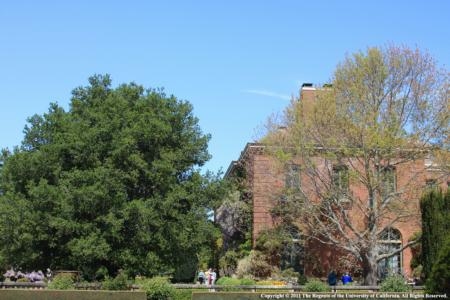
UC's oak publication addresses not only the above ground portion of the trees, but also what is going on in the root zone.
Bringing ants to their 'skinny little knees'
Redding Record Searchlight columnist Laura Christman described her reaction to a stubborn ant problem with hyperbole and maybe a tiny bit of truth in a recent column.
"Get out! I do not care if I have to spray you with a chemical that has the half-life of plutonium and kills all living things within three blocks. I want you GONE!" Christman wrote.
"I did not actually say that," Christmas confessed. "But I thought it. And right about then, the ants left . . . . I know they will be back."
That's why, she said, she was pleased to have the opportunity to review UC ANR's new publication Urban Pest Management of Ants in California. The 72-page book, which details environmentally sound ant control measures, was written for pest control professionals, but is also a helpful reference for homeowners. The publication is available in the ANR Catalog for $20.
After talking to the author, UC Riverside entomology specialist emeritus John Klotz, and reading the book, Christmas reached a common sense conclusion: Controlling ants is not a matter of doing one thing, but several things.
Klotz told Christman that ants can be persistent, but with persistence they can be controlled.
"So I'm not giving up," Christman declared. "I hope to determine just who my ants are and then bring them to their skinny little knees."
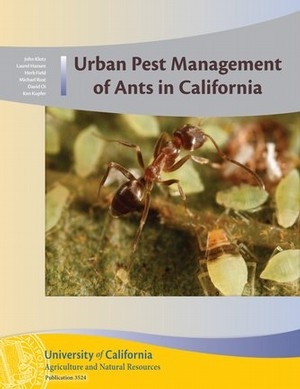
A new publication that details urban ant control.

